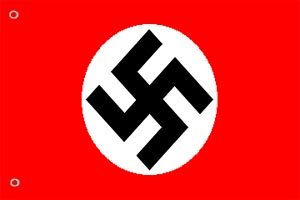"In 1932 the Protestant church came under the influence of the Nazi movement called "German Christians" (Bewegung Deutscher Christen, also called "Stormtroopers of Jesus") and lead by the founder, Rev. Joachim Hossenfelder. This movement represented Hitler's "Positive Christianity" views and lawfully encoded into the Nazi "constitution." Hitler tried to force regional Protestant churches to merge into the Protestant Reich Church. Protestant churches throughout Germany participated in the movement but Hitler's union of the churches failed because of in-church bickering. Only one visibly apparent church remains in Germany that shows distinctive markings of Positive Christianity, a reminder of how Christianity and Nazism mixed together during the Nazi regime."1

Consecrated in 1935, the Martin Luther Memorial Church in Berlin still stands. Originally the Church bells and altar contained the swastika, but later removed because of post-war law that outlaws swastikas in Germany. Nevertheless, the church still retains many of the Nazi symbols and icons, including a muscular Aryan Jesus, Iron cross, statues of Nazi stormtroopers, and a bust of Adolf Hitler. During the 30s, Nazi party members made up two thirds of the church attendance, where they also baptized their children.This building is now up for sale. A search of the internet reveals that the building was closed in 2007. A current article from The Telegraph reveals that "Berlin's Nazi-era church" is for sale. The building reveals the uncomfortably close links forged between churches and the Nazis. Plans to transform the building into a theatre or museum depend on finding a buyer.
From time to time I shall share more about how and why Lutheranism was influenced by Nazism in the 1930s.
